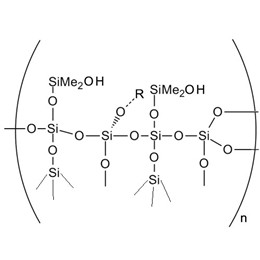To achieve the effect of foam control caused in the production process, silicone antifoam is commonly used in many industrial processes: wastewater treatment, food processing, pulp and paper industry, etc. Some people often ask: how does it work to control foam? As a silicone defoamer raw material manufacturers to tell you the answer:
Silicone defoamer works in the foam thin layer formation stage or after. Silicone-based defoamers penetration into the existing foam elastic film after the distribution in the film, through the reduction to very low surface tension, leads to thin layer rupture; or the formation of the single-molecule film, so that its adhesion is reduced, easy to thin layer rupture; defoamer containing hydrophobic particles to the surface of the thin layer, in the top of the thin layer adsorption surfactant, so that the thin layer due to the lack of surfactant and rupture.
![]()
1. Contacting with defoaming agents→2. Molecule diffusion
![]()
→3. Molecules enter into the bubble film→4. Bubble film thinning→5. Controlling foam to burst
This article will continue to explore the following topics:
1. What is the cause of foam generation in production?
2. Why do we need to use silicone antifoam?
3. How to formulate silicone antifoam?
4. Advantages of using MQ resin in silicone defoamers?
5. How to choose a good quality product for your silicone-based defoamers?
What is the cause of foam generation in production?
Take paints and coatings as an example:
There are various additives added to the coatings formula, such as additives to help the wetting and dispersing of color fillers, additives to adjust the appearance of the paint film flat, and some special functions of additives. Most of these additives are surfactants, which can change the surface tension of the paint, resulting in the existence of easy foaming or foam stabilization of the internal factors. The coating manufacturing process uses various high-speed mixing equipment such as dispersion machine, sand mill, etc., and various construction methods such as aerial spraying, airless spraying, roller coating and brush coating used in paint coating, etc. These manufacturing and construction processes will increase the free energy of the paint system to varying degrees and help generate foam, which is an external factor to generate foam.
The liquid reflux phenomenon of surfactant causes bubbles to form a stable state, counteracting the inhibiting effect of gravity on bubbles, while the electrostatic repulsion of surfactant thickens the bubble wall film and makes it less likely to break.
![]()
Why do we need to use silicone antifoam?
A large number of stable unwanted foam are not conducive to the smooth chemical processing and packaging of products, and may even affect the effectiveness and performance of products in industrial applications, so it is necessary to add silicone antifoam agents to effectively make foam control.
How to formulate silicone antifoam?
The main active silicone defoamers are dimethyl silicone oil and silica, MQ resin is used with silica-dimethyl silicone oils defoamer system, generally the amount of resin added is 8%-12%.
On the basis of the basic defoamer, MQ resin and silicone oil molecules and silica molecules generate a more stable structure to improve the bubble inhibition performance. And this extremely stable structure can improve the stability of silicone defoamers, improve acid resistance and high temperatures resistance. While improving the defoaming performance, the active ingredients of the dimethyl silicone oil silica system are protected from being destroyed by high temperature and acidity and alkalinity by this embedded break structure.
Advantages of using MQ resin in silicone defoamers?
MQ resin is a raw material of antifoaming agents, which could be easily dispersed in the dimethyl silicone oils silica system to provide excellent defoaming properties, increase temperature and acid resistance of defoamer, and maintain the activity of active silicone ingredients. MQ resin can absorb and decompose organics, such as proteins organic matter, etc., making it work more effectively in many industries.
- Improve the high-temperatures resistance of defoamers.
- Improve the strong alkaline resistance of defoamers.
- Improve the defoaming performance of defoamers.
- High-performance silicone compound defoamers, it is recommended to add 8-12% MQ resin to silicone grease to significantly improve the defoaming performance of silicone antifoam.
How to choose a good quality product for your silicone-based defoamers?
XJY Silicones is devoted to providing a wide variety of silicone antifoam solutions to you. Please contact us to learn more.
XJY-8205 methyl MQ silicone resin series is a condensation consisting of four functional groups siloxane (Q) and one functional group methyl siloxane (M), the molecular structure of M and Q chain ratio, and the structural properties of M to determine the resin application. XJY-8205 is blended with linear polysiloxanes and other raw materials to form silicone polymers with a certain degree of cross-linking. It has a good application effect in silicone antifoam in printing and dyeing, petroleum exploration, pulp and paper-making, and other various industries processes.

